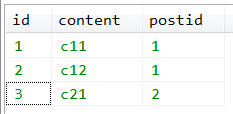什么是模型?
我們的web系統(tǒng)一定會(huì)和各種數(shù)據(jù)打交道,實(shí)際開發(fā)過程中,往往一個(gè)類對(duì)應(yīng)了關(guān)系數(shù)據(jù)庫的一張或多張數(shù)據(jù)表,這里就會(huì)出現(xiàn)兩個(gè)問題。
1.類和數(shù)據(jù)表,一方修改會(huì)導(dǎo)致另一方的修改,只要數(shù)據(jù)表結(jié)構(gòu)不定下來,業(yè)務(wù)邏輯的開發(fā)幾乎沒法開工
2.獲取數(shù)據(jù)時(shí)會(huì)牽涉很多sql語句的拼接,如果數(shù)據(jù)結(jié)構(gòu)變動(dòng),這些sql需要改寫
假如要開發(fā)一個(gè)博客系統(tǒng),我們先設(shè)計(jì)兩個(gè)model和兩張數(shù)據(jù)表
第一張數(shù)據(jù)表,表名是post,存儲(chǔ)了博客文章,數(shù)據(jù)如下:

第二章數(shù)據(jù)表,表名是comment,存儲(chǔ)了博客文章的評(píng)論,數(shù)據(jù)如下:

post和comment是一對(duì)多的關(guān)系,每一篇博客文章對(duì)應(yīng)了多條評(píng)論,每一條評(píng)論只屬于一篇文章。
model類的設(shè)計(jì)之前,我們先定義好三個(gè)接口
|
1
2
3
4
5
|
interface imodel{ public static function all(); public static function get($id); public static function where($condition,$value);} |
定義model類
|
1
2
3
4
5
6
7
8
9
10
11
12
13
14
15
16
17
18
19
20
21
22
|
class model implements imodel{ public static $table; public static $db; public function __construct(){ self::$db=new mysql(); } public static function get($id){ return self::where('id',$id); } public static function where($condition,$value){ $sql=sprintf("select * from %s where %s='%s'",self::$table,$condition,$value); return self::$db->query($sql); } public static function all(){ $sql=sprintf("select * from %s",self::$table); return self::$db->query($sql); }} |
這三個(gè)接口分別負(fù)責(zé)了三種查詢:遍歷查詢,條件查詢,按編號(hào)查詢,其實(shí)這三種接口的設(shè)計(jì)并不是最科學(xué)的,甚至get方法不過是where的一種特殊形式,但是這樣的設(shè)計(jì)并不影響我們工程,甚至也有助于理解,我們后期會(huì)對(duì)這段代碼做改動(dòng)。
之所以在model類里就完成了sql的拼接,就是希望在子類中不必重復(fù)再寫sql。
然后是post類的定義
|
1
2
3
4
5
6
7
|
class postmodel extends model{ public $postid; public function __construct(){ parent::__construct(); parent::$table='post'; }} |
還有comment類的定義
|
1
2
3
4
5
6
7
|
class commentmodel extends model{ public $commentid; public function __construct(){ parent::__construct(); parent::$table='comment'; }} |
我們可以在控制器的方法中寫這樣的代碼來完成調(diào)用數(shù)據(jù)
|
1
2
3
4
5
6
7
8
|
$post=new postmodel();$post::all();$arr=$post::get('1');var_dump($arr);$comment=new commentmodel();$arr=$comment::get('2');var_dump($arr); |
我們發(fā)現(xiàn),這樣的代碼很簡潔,但是問題也隨之而來,我們sql查詢時(shí)候,還有很多復(fù)雜的聯(lián)表查詢?nèi)鏹oin操作,如此,拼接sql還是不可避免的,這個(gè)復(fù)雜的問題,我們放在后面解決。
模型與數(shù)據(jù)庫
先寫一個(gè)db抽象類,規(guī)定類需要實(shí)現(xiàn)的方法
|
1
2
3
4
5
6
7
8
9
10
11
|
abstract class db{ private $ip; private $user; private $pwd; private $name; private $connection; abstract public function execute($sql); abstract public function query($sql);} |
這里以mysql數(shù)據(jù)為例,當(dāng)然你也完全可以實(shí)現(xiàn)一套sqlite數(shù)據(jù)庫的接口。
|
1
2
3
4
5
6
7
8
9
10
11
12
13
14
15
16
17
18
19
20
21
22
23
24
25
26
27
28
29
30
31
32
33
34
35
36
|
class mysql extends db{ public function mysql(){ /*config*/ $this->ip='*'; $this->serverid='*'; $this->serverpassword='*'; $this->databasename='*'; /*end of config*/ $this->connection=mysqli_connect($this->ip,$this->serverid,$this->serverpassword,$this->databasename); if(!$this->connection){ die('could not connect'.$this->connection); } mysqli_query($this->connection,'set names utf8'); } public function execute($sql){ return mysqli_query($this->connection,$sql); } public function query($sql){ $result=mysqli_query($this->connection,$sql); $arr=array(); while($row=mysqli_fetch_array($result)){ $arr[]=$row; } return $arr; } public function close(){ mysqli_close($this->connection); }} |
談到數(shù)據(jù)庫類,上述的寫法仍不是最好的,因?yàn)槲覀兛梢允褂脝卫J絹肀WCdb類只有一次初始化,來節(jié)省硬件資源的開銷,但這不是本節(jié)的主題,我們把設(shè)計(jì)模式放在之后來談。
原文鏈接:http://www.cnblogs.com/sweng/p/6624845.html













